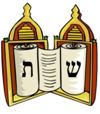
ק׳ ק׳ שׁערי תפילה

******


*****

******

****
לוח זמני תפלה לחורף תשפ״ד
מוצאי שבת | ערבית )מוצ“ש( | מנחה | סוף זמן קריאת שמע | זמן שבת | פלג המנחה (תה״ד) | פלג המנחה (לבוש) | מנחה וקבלת שבת | תאריך | שבת פרשת |
Shabbat Ends | Arbit | Mincha | Shema before | Latest Candle lighting |
| Earliest Candle lighting | Mincha & Kabbalat Shabbat | Date | Parasha |
PM | PM | PM | AM | PM | PM | PM | PM |
|
|
8:46 | 8:42 | 6:30 | 9:50 | 7:37 | 7:01 | 6:30 | 6:45 | 5/6 Apr | שמיני |
Please Note Changes
to the
Times on Shabbat
שבת
קרבנות
9:00 am
הודו
9:15 am
Please Note change from the printed
timetables which had Mincha on Shabbat at 6pm
This has now changed to
6:30 pm
due to popular demand
מנחה
6:30 pm
**********
On the eighth day of the dedication of the Mishkan, Aharon, his sons, and the entire nation bring various korbanot (offerings) as commanded by Moshe. Aharon and Moshe bless the nation. Hashem allows the Jewish People to sense His Presence after they complete the Mishkan. Aharon's sons, Nadav and Avihu, innovate an offering not commanded by Hashem. A fire comes from before Hashem, consuming them and stressing the need to perform the commandments only as Moshe directs. Moshe consoles Aharon, who grieves in silence. Moshe directs the kohanim regarding their behavior during the mourning period, and warns them that they must not drink intoxicating beverages before serving in the Mishkan. The Torah lists the two characteristics of a kosher animal: It has split hooves, and it chews, regurgitates, and re-chews its food. The Torah specifies by name those non-kosher animals which have only one of these two signs. A kosher fish has fins and easily removable scales. All birds not included in the list of forbidden families are permitted. The Torah forbids all types of insects except for four species of locusts. Details are given of the purification process after coming in contact with ritually impure species. The Jewish People are commanded to be separate and holy — like Hashem.
Ohr Somayach Institutions www.ohr.edu

דין הכשר כלים לפסח
בהלכות
הקודמות
הזכרנו
שאין להשתמש בפסח בכלי חמץ, מפני שהם בלועים מחמץ כמו שהסברנו.
והנה
דיני הכשר כלים לפסח הם קשים גם מבחינה הלכתית וגם מבחינה מעשית, ומרן רבינו הגדול
רבי עובדיה יוסף זצ”ל סידר לנו בחבוריו ובשעוריו את דיני הכשרת הכלים לחג
הפסח.
כל
כלי, דרך ההכשר שלו היא כפי דרך השימוש בו, משום שכלל יש בידינו “כבולעו כך
פולטו” ולפיכך כלי שדרך השימוש בו היא על ידי בישול, כגון סיר בישול,
דרך
ההכשר שלו היא כתשמישו, והיינו להגעילו, כלומר לטובלו, בתוך כלי עם מים רותחים.
וצריך שיהיו המים רותחים בכלי ראשון, (כלומר, יש להגעיל את הכלי במים רותחים
שנמצאין בכלי הראשון שבו הם רתחו, אבל אין להגעיל את הכלי בתוך מים רותחים ששפכו
אותם מהכלי שבו הם רתחו לכלי אחר, כי כלי זה כבר אינו כלי ראשון, אלא כלי שני,
ואין המים שבכלי שני רותחים דיים בכדי לגרום להפלטת מה שבלוע בתוך הכלי שמטבילים
בתוכו.) ולכן סכינים וכפות וכיוצא בזה, אפשר להגעילם על ידי שיטבלם בתוך מים
רותחים שבקומקום החשמלי, על ידי שיטביל תחילה צד אחד של הסכין ולאחר מכן את צידו
השני. (ואם הידית של הסכין עשויה עץ אי אפשר להכשירה בהגעלה).
קודם
ההגעלה יש לנקות את הכלים היטב לבל ישאר בהם שום שמץ לכלוך או חלודה.
שפודים
ואסכלאות שמשתמשים בהם באש בלא אמצעות נוזלים, צריכים ליבון באש ממש עד שיהיו
ניצוצות ניתזין מהם, דהיינו עד שיאדים הברזל. וכן הדין ב”סיר פלא”
שאופים
בו עוגה חמץ על גבי הכיריים במשך כל ימות השנה, ההכשר שלו הוא רק על ידי
“ליבון חמור” דהיינו ליבון על גבי אש עד שיאדים הברזל. ובסירים בדרך כלל
הדבר אינו אפשרי מבחינה מעשית ולכן בהכרח יש לקנות סיר חדש. אבל סיר שהשתמשו בו רק
לבישול, יש לו הכשר כאמור על ידי הגעלה ברותחין.
החצובה,
שהיא
הברזל המונח סמוך לאש על גבי הכיריים, יש לנקותה ולהגעילה ברותחין.
ואם
עירה עליה (שפך עליה) מים רותחים מכלי ראשון, הוכשרה בכך. ומותר להשתמש בה בפסח.
ובהלכה
הבאה נבאר עוד פרטי דינים בזה.
The Laws of Koshering Vessels for Pesach
In
the previous
Halacha, we have explained
that one should not use Chametz vessels on Pesach since they have Chametz
flavor absorbed in them. Since the laws of koshering vessels for Pesach are
difficult both from a halachic and a practical
perspective, Maran Rabbeinu Ovadia Yosef zt”l
has arranged these laws for us in a clear and concise manner in his lectures as
well as in his works.
A vessel is koshered in the same manner it is generally used, for we have a
rule, “The same way it absorbs is the same way it releases.” Therefore, any
vessel which is used for cooking, such as a pot, the method of koshering it is
the same way it is used, i.e. a process called “Hag’ala” which is immersing it
in a pot of boiling water. The boiling water must be in “Keli Rishon” (meaning
that the vessel must be immersed into boiling water which is in the original
vessel where the water was boiled in and is still on the flame; however, one
should not perform Hag’ala in a vessel which the water was not originally
boiled in and was merely poured into from the original vessel which was on the
fire, for this vessel is not considered a “Keli Rishon” and is merely a “Keli
Sheni.” The water in a “Keli Sheni” is not considered boiling enough to cause
the vessel immersed into it to release its Chametz flavor). Thus, knives,
spoons, and the like can be koshered by immersing them into water boiled in a
pot on the flame or an electric kettle by first immersing one end of the knife
followed by the other end. (If the handle of the knife is made of wood, it
cannot be koshered through Hag’ala.)
Before performing Hag’ala, one must clean the vessel thoroughly and make sure
no residue or rust remains.
Skewers and spits which are used with fire but without liquids must be torched
with fire until sparks emerge, i.e. when the metal turns red. The same applies
to a “Wonder Pot” which is used to bake Chametz cakes throughout the year which
can only be koshered by torching it with fire until the metal turns red-hot.
Usually, this is not practical with regards to pots and one must therefore
purchase new pots for Pesach. Nevertheless, a pot which was used only for
cooking Chametz throughout the year can be koshered with Hag’ala as we have
explained.
The grate, which is the square or round metal piece which the pots and pans sit
on the stovetop during cooking, should be koshered by cleaning it well and
immersing it into boiling water in a Keli Rishon. However, if one pours boiling
water from a Keli Rishon onto it, it is nevertheless koshered and is then
permissible for use on Pesach.
In the next Halacha, we shall, G-d-willing, discuss this
matter further.
דיני
הכשר כלים לפסח (המשך)
ביארנו,
שיש
להשתמש בפסח בכלים שלא נבלע בהם חמץ, דהיינו כלים חדשים (או מיוחדים לפסח), או
כלים שהוכשרו לפסח. ובדרך כלל דרך ההכשר של הכלי הוא כדרך השימוש בו.
צלחות
וקערות, ששמים בהן מאכלים חמים, אבל לא משתמשים בהן ככלי ראשון ממש,
דהיינו שהדרך היא שכששמים בהן מאכל, יוצקים אותו לתוכן מתוך סיר אחר, (שאותו סיר
הוא היה הכלי הראשון שרתחו בו המים) הכשרן הוא כדרך שימושן, דהיינו על ידי שיערו (מלשון עירוי
– שפיכה) עליהם מים רותחים מכלי ראשון (למשל, מתוך הקומקום החשמלי שבו רתחו המים),
וכל שכן שניתן להכשירם על ידי הגעלה ממש, דהיינו להטבילן בתוך מים רותחים בכלי
הראשון שהם רותחים בו.
מחבת,
שמטגנים
בו מאכלי חמץ בשמן, נחלקו בו הפוסקים אם דינו כדין סיר שמבשלין בו תבשילים של חמץ
שדי לו בהגעלה, או שמא מכיון שאין בו נוזלים כל כך, דינו כדין שיפודים שצריכים
ליבון על ידי אש. ומנהג הספרדים הוא שדי למחבת בהגעלה, ואילו למנהג האשכנזים יש
להצריך ליבון באש למחבת. וכתב מרן רבינו הגדול רבי עובדיה יוסף זצ”ל, שאף
למנהג האשכנזים אין להצריך שהמחבת תרתח על ידי אש עד שהיא תאדים אלא די בליבון קל,
דהיינו שהמחבת תתחמם עד שאם ישימו עליה קש הוא ישרף.
כל
כלי שלא השתמשו בו ברותחין, כגון כלי כסף, וכן המקרר והמקפיא וכדומה, אינם צריכים
שום הכשר, ודי להם בניקוי היטב בלבד.
כלי
חרס אין להם שום הכשר כלל ואף אם ילבנם היטב באש, לעולם הם עומדים באיסורם. וכלי
זכוכית, אינם צריכים הכשר כלל ולדעת מרן השלחן ערוך די להם בשטיפה כהוגן, אך מנהג
האשכנזים להחמיר בזה. וכבר הזכרנו מחלוקת זו בהלכות בשר וחלב. כלי פורצליין, אף
למנהג הספרדים, דינם ככלי חרס ולא מועיל להם שום הכשר.
יש
להשתדל ככל האפשר שהכלים יוגעלו לאחר שיעברו עליהם עשרים וארבע שעות בלי שימוש.
ומותר להגעיל כלי חלב וכלי בשר בזה אחר זה, בתוך כלי
גדול.
The Laws of Koshering Vessels for Pesach-Continued
We
have explained that on Pesach one must use vessels and dishes
that have not absorbed Chametz, meaning either new vessels (or vessels
designated specially for Pesach use) or vessels that have been koshered for
Pesach. Usually, the way to kosher a vessel is in the same manner it is
normally used.
Regarding plates and bowls that hot foods are placed in but are not used as a
real “Keli Rishon” (i.e. a vessel with boiling hot liquid directly on the fire
or heat source), meaning that when food is placed in them, it is usually dished
out of another pot (and this pot was the “Keli Rishon” where the water was
actually boiled), their koshering process is in the way it is used, i.e.
through pouring boiling water on them from a “Keli Rishon” (for instance, from
an electric kettle that water was boiled in). Certainly, these items may be
koshered through “Hag’ala,” meaning immersing them into boiling water in a
“Keli Rishon” where the water was boiled.
Regarding pans that are used to fry Chametz foods in oil, the is a disagreement
in the Poskim whether it can be halachically considered like a pot that Chametz
foods are cooked in and Hag’ala will be sufficient or since not much liquid is
used to fry foods in it, it should have the halachic
status of skewers which require “Libun,” torching with fire. The custom of
Sephardic Jewry is that Hag’ala is sufficient for frying pans, while the
Ashkenazim customarily require Libun with fire for these pans. Maran Rabbeinu
Ovadia Yosef zt”l
writes that even according to the Ashkenazi custom, it is not necessary to fire
up the pan to such a degree that it turns red-hot; rather, a light Libun, i.e.
that it becomes hot enough from the fire that if a straw would come in contact
with the pan it would burn, is sufficient.
Any vessels not used with hot foods or liquids, such as silver goblets,
refrigerators, and freezers, do not require any koshering and a thorough
cleaning is sufficient.
Vessels made of pottery are unable to be koshered; even if they were to be
torched with fire very well, they would remain in their forbidden state.
According to Maran Ha’Shulchan Aruch, glass vessels need no koshering and
washing it well will be sufficient. However, Ashkenazim customarily act
stringently regarding glass vessels. Even according to the custom of the Sephardim,
porcelain vessels are treated as pottery and cannot be koshered.
It is preferable, wherever possible, to perform Hag’ala on vessels needing
koshering only after they have not been used for twenty-four hours. It is
permissible to perform Hag’ala on meat and dairy vessels one after another when
the Hag’ala is being done in a large pot.